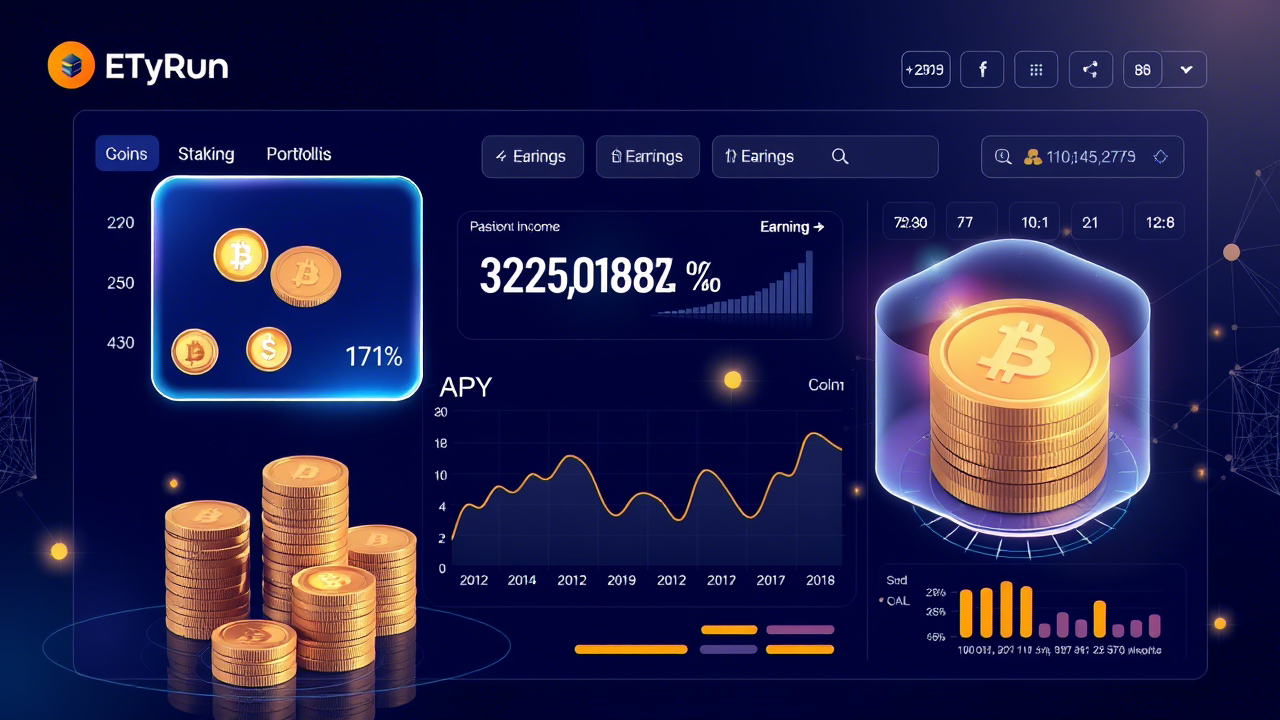The digital asset revolution has opened numerous avenues for investors to generate passive income, with crypto staking emerging as one of the most promising strategies. Unlike traditional investments that require active management, staking allows you to earn rewards simply by holding specific cryptocurrencies in designated wallets or platforms. This comprehensive guide explores everything you need to know about crypto staking, from understanding the fundamentals to maximizing your earning potential.
Crypto staking represents a paradigm shift in how investors can approach digital asset holdings. Rather than leaving your cryptocurrencies idle in a wallet, staking enables you to participate in blockchain network operations while earning consistent rewards. This method has gained tremendous popularity among both institutional and retail investors seeking sustainable income streams from their digital portfolios. Before diving into staking, it’s essential to understand the fundamentals of cryptocurrency investment and how blockchain technology enables these earning opportunities.
What is Staking in Crypto
Crypto staking involves holding and “locking up” specific cryptocurrencies to support blockchain network operations. When you stake your digital assets, you’re essentially participating in the network’s consensus mechanism, helping to validate transactions and maintain blockchain security. In return for this contribution, you receive staking rewards, typically paid in the same cryptocurrency you’re staking.
The staking process works through proof-of-stake (PoS) consensus mechanisms, where validators are chosen to create new blocks and verify transactions based on the amount of cryptocurrency they’ve staked. The more tokens you stake, the higher your chances of being selected as a validator and earning rewards. This system replaces the energy-intensive mining process used in proof-of-work blockchains like Bitcoin. Understanding cryptocurrency trading strategies can help you make better decisions about when to stake versus trade your digital assets.
Modern staking has evolved beyond simple validation. Many platforms now offer liquid staking, allowing you to earn rewards while maintaining access to your funds through derivative tokens. This flexibility has made staking more attractive to investors who want to maximize their returns without completely locking up their capital. For those new to digital assets, learning about crypto wallets is crucial for secure staking.
Proof of Stake Consensus Mechanism
Proof of stake represents a revolutionary approach to blockchain consensus that prioritizes energy efficiency and scalability. Unlike proof-of-work systems that require massive computational power, PoS networks select validators based on their stake in the network. This method significantly reduces energy consumption while maintaining robust security. According to Wikipedia’s explanation of proof-of-stake, this consensus mechanism was first implemented to address the environmental concerns associated with traditional blockchain mining.
The PoS mechanism works by having validators propose and vote on new blocks. Validators are selected randomly, with selection probability proportional to their stake size. When a validator successfully processes a block, they receive rewards distributed among all stakers proportionally. This system incentivizes honest behavior, as malicious validators risk losing their staked tokens through slashing penalties.
Major blockchain networks like Ethereum, Cardano, and Polkadot have successfully implemented PoS consensus mechanisms. Ethereum’s transition from proof-of-work to proof-of-stake in 2022, known as “The Merge,” demonstrated the viability and benefits of PoS for large-scale networks. This transition reduced Ethereum’s energy consumption by over 99% while maintaining network security and decentralization.
Cryptocurrency Earnings Through Staking
Staking offers multiple pathways to generate cryptocurrency earnings, making it an attractive option for passive income seekers. The primary earning mechanism involves receiving regular rewards for participating in network validation. These rewards typically range from 3% to 20% annually, depending on the specific cryptocurrency and network conditions.
Beyond basic staking rewards, many platforms offer additional earning opportunities through compound staking. This approach automatically reinvests your earned rewards back into staking, creating a compounding effect that can significantly boost long-term returns. Some platforms also provide bonus rewards for long-term staking commitments or participation in governance activities.
Advanced stakers can explore yield farming opportunities that combine staking with decentralized finance (DeFi) protocols. These strategies often involve providing liquidity to decentralized exchanges while simultaneously staking tokens, potentially earning multiple income streams. However, these complex strategies require thorough understanding of smart contract risks and market dynamics.
Passive Crypto Income Strategies
Building passive crypto income through staking requires strategic planning and portfolio diversification. Successful stakers typically allocate their holdings across multiple cryptocurrencies and staking platforms to minimize risk while maximizing returns. This approach helps protect against potential losses from any single asset or platform failure.
Dollar-cost averaging into staking positions can help reduce the impact of market volatility on your overall returns. Instead of investing a lump sum, gradually building your staking positions over time can help you achieve better average entry prices while maintaining consistent earning potential. This strategy works particularly well for long-term investors focused on passive income generation.
Automated staking platforms have simplified the process of earning passive income from digital assets. These platforms handle the technical aspects of staking, including validator selection, reward distribution, and portfolio rebalancing. While these services typically charge fees, they provide convenience and professional management that can justify the costs for many investors.
Crypto Staking Platforms
Choosing the right staking platform is crucial for maximizing your returns while minimizing risks. Centralized exchanges like Binance, Coinbase, and Kraken offer user-friendly staking services with competitive rates and professional management. These platforms typically handle all technical aspects of staking, making them ideal for beginners who want to start their crypto investment journey without technical complexity.
Decentralized staking platforms provide more control over your assets while offering potentially higher rewards. Platforms like Lido, Rocket Pool, and Marinade Finance allow you to stake directly on blockchain networks while maintaining custody of your tokens through smart contracts. These platforms often offer liquid staking tokens that can be traded or used in DeFi applications. When choosing between exchanges, consider reading about the best crypto exchanges in India for comprehensive platform comparisons.
When evaluating staking platforms, consider factors beyond just reward rates. Platform security, reputation, fee structures, and withdrawal flexibility are equally important. Some platforms offer instant unstaking, while others require waiting periods that can last days or weeks. Understanding these trade-offs helps you choose platforms that align with your investment goals and risk tolerance. Current market data from CoinMarketCap and CoinGecko can help you compare staking rewards across different platforms.
Best Crypto Staking Coins
Selecting the right cryptocurrencies for staking requires careful analysis of multiple factors including reward rates, network security, and long-term viability. Ethereum remains one of the most popular staking options, offering around 3-5% annual rewards with strong network security and widespread adoption. For those interested in purchasing Ethereum for staking, our guide on how to buy Bitcoin provides similar processes applicable to other major cryptocurrencies.
Cardano has gained popularity among stakers due to its robust proof-of-stake mechanism and consistent rewards ranging from 4-6% annually. The network’s focus on sustainability and academic research has attracted long-term investors seeking stable returns. Cardano’s staking mechanism also allows for flexible delegation without locking up funds. When evaluating which cryptocurrencies to stake, consider reviewing the top crypto apps that support multiple staking options.
Solana offers attractive staking rewards typically ranging from 6-8% annually, supported by high transaction throughput and growing ecosystem adoption. However, the network has experienced occasional outages that highlight the importance of diversification. Other notable staking options include Polkadot, Avalanche, and Cosmos, each offering unique features and reward structures. For comprehensive analysis of various cryptocurrencies, check current market data on CoinMarketCap and CoinGecko for real-time staking statistics.
Crypto Staking Rates and APY
Understanding staking rates and annual percentage yields (APY) is essential for making informed investment decisions. Staking rates vary significantly across different cryptocurrencies and platforms, influenced by factors such as network inflation, total amount staked, and validator performance.
Higher APY doesn’t always translate to better returns when factoring in price volatility and token economics. A cryptocurrency offering 20% staking rewards but experiencing significant price decline may deliver negative real returns. Conversely, a stable cryptocurrency with 5% staking rewards might provide better risk-adjusted returns over time.
Dynamic staking rates mean that your actual returns can fluctuate based on network participation and market conditions. Networks with low staking participation typically offer higher rewards to incentivize more validators. As participation increases, rewards may decrease, creating a natural balancing mechanism that maintains network security.
Highest APY Crypto Staking Opportunities
While high APY opportunities can be attractive, they often come with increased risks that require careful evaluation. Newer blockchain networks frequently offer higher staking rewards to bootstrap network security and attract validators. However, these networks may lack the stability and security of established platforms.
Some DeFi protocols offer extremely high staking rewards through token emissions and incentive programs. These yields can reach 50-100% APY or higher, but they’re often unsustainable and may involve complex smart contract risks. Understanding the underlying economics of these rewards is crucial for risk assessment.
Liquid staking derivatives have created new opportunities for high APY through leveraged staking strategies. These approaches involve borrowing against staked assets to increase position sizes, potentially amplifying returns. However, leverage also amplifies losses, making these strategies suitable only for experienced investors with high risk tolerance.
Crypto Staking Calculator Tools
Staking calculators are invaluable tools for estimating potential returns and comparing different staking opportunities. These calculators typically consider factors such as initial investment amount, staking duration, expected APY, and compounding frequency to provide realistic return projections.
Advanced calculators incorporate additional variables like token price volatility, network inflation rates, and platform fees. Some tools also factor in tax implications and compare staking returns to alternative investment strategies. These comprehensive calculators help investors make more informed decisions about their staking allocations.
When using staking calculators, remember that projections are based on current conditions that may change over time. Market volatility, network upgrades, and regulatory changes can all impact actual returns. Using calculators as starting points for analysis rather than definitive predictions helps maintain realistic expectations.
Crypto Staking Risks and Safety Concerns
Despite its potential benefits, crypto staking involves several risks that investors must understand and manage. Smart contract risks represent one of the primary concerns, as bugs or vulnerabilities in staking protocols can result in permanent loss of funds. Even well-audited protocols can contain unknown vulnerabilities that malicious actors might exploit.
Slashing penalties pose another significant risk for validators who fail to meet network requirements or engage in malicious behavior. While most retail stakers delegate to professional validators, choosing unreliable validators can result in penalty losses. Researching validator performance and reputation is crucial for minimizing slashing risks.
Market volatility affects staking returns significantly, as token price movements can overshadow staking rewards. A cryptocurrency earning 10% staking rewards but losing 50% of its value still results in substantial losses. Diversification across multiple assets and time horizons can help mitigate this risk.
Is Staking Crypto Safe
The safety of crypto staking depends largely on the specific platforms and cryptocurrencies chosen. Established networks with long track records and professional validator services generally offer better security than newer or experimental platforms. However, even established networks can experience technical issues or security breaches.
Platform security varies significantly between centralized and decentralized staking options. Centralized platforms may offer better customer support and insurance coverage, but they also present counterparty risks if the platform fails or gets hacked. Decentralized platforms provide more control but require users to manage their own security.
Regulatory uncertainty adds another layer of risk to crypto staking. Government regulations could potentially impact staking rewards, platform operations, or token classifications. Staying informed about regulatory developments in your jurisdiction helps manage these risks effectively.
Crypto Staking Scams and Red Flags
The popularity of crypto staking has attracted numerous scammers offering unrealistic returns or operating fraudulent platforms. Common scams include Ponzi schemes disguised as staking platforms, fake staking pools, and phishing attacks targeting staker credentials.
Unrealistic return promises represent major red flags in the staking space. While high APY opportunities exist, promises of guaranteed returns exceeding 100% annually should be treated with extreme skepticism. Legitimate staking returns are typically modest and reflect actual network economics.
Unregulated platforms operating without proper licenses or disclosures pose significant risks to stakers. Before committing funds to any staking platform, research the company’s background, regulatory status, and user reviews. Platforms that lack transparency about their operations or fee structures should be avoided.
Crypto Staking Projects and Programs
Numerous innovative staking projects have emerged, each offering unique approaches to earning passive income from digital assets. Institutional staking programs provide professional management services for large investors, offering competitive rates with enhanced security measures and regulatory compliance.
Community-driven staking programs allow individual investors to pool resources and share rewards while maintaining decentralization. These programs often involve governance tokens that give participants voting rights on network decisions, creating additional value beyond staking rewards.
Cross-chain staking protocols enable staking across multiple blockchain networks through interoperability solutions. These platforms allow investors to diversify their staking exposure while maintaining simplified management through unified interfaces.
Crypto Staking Companies and Service Providers
The staking industry has attracted numerous companies offering specialized services to different investor segments. Professional staking services cater to institutional investors with large asset holdings, providing white-glove service, regulatory compliance, and institutional-grade security.
Retail-focused staking companies emphasize user experience and accessibility, offering mobile apps, educational resources, and customer support. These companies often provide staking-as-a-service solutions that handle technical complexity while maintaining competitive reward rates.
Infrastructure providers support the staking ecosystem by offering validator services, monitoring tools, and technical infrastructure. These companies play crucial roles in maintaining network security and reliability, though they typically serve professional validators rather than retail stakers.
Is Crypto Staking Worth It
The value proposition of crypto staking depends on individual investment goals, risk tolerance, and market conditions. For investors seeking passive income from digital asset holdings, staking offers compelling opportunities with reasonable risk profiles when properly implemented.
Long-term investors who believe in the future of blockchain technology may find staking particularly attractive, as it provides ongoing income while maintaining exposure to potential price appreciation. This combination of income and growth potential makes staking suitable for various investment strategies.
However, staking isn’t suitable for all investors. Those requiring immediate liquidity, uncomfortable with technology risks, or seeking guaranteed returns may find traditional investment options more appropriate. Careful consideration of personal circumstances and investment objectives is essential.
Is Crypto Staking a Good Investment Strategy
Crypto staking can be an excellent investment strategy when implemented as part of a diversified portfolio. The combination of passive income generation and potential capital appreciation makes staking attractive for long-term wealth building. However, success requires careful asset selection, platform evaluation, and risk management.
The regulatory environment for crypto staking continues evolving, with some jurisdictions providing clear frameworks while others remain uncertain. Investors should stay informed about regulatory developments that could impact staking rewards or platform operations in their jurisdictions.
Technical innovations in staking continue improving accessibility and returns. Developments like liquid staking, multi-chain staking, and automated yield optimization are making staking more attractive to mainstream investors. These innovations suggest that staking will remain a viable investment strategy for the foreseeable future.
FAQ
What is the minimum amount required to start crypto staking?
The minimum staking amount varies significantly by cryptocurrency and platform. Some networks like Ethereum require 32 ETH for solo staking, while many platforms allow staking with much smaller amounts through pooled staking services. Most centralized exchanges have no minimum requirements, making staking accessible to retail investors.
How long does it take to receive staking rewards?
Staking reward distribution varies by network and platform. Most networks distribute rewards daily or weekly, while some may have longer periods. The initial rewards typically begin within a few days to weeks after starting staking, depending on the network’s epoch structure and validation cycles.
Can I unstake my cryptocurrency at any time?
Unstaking flexibility depends on the specific cryptocurrency and staking method. Some platforms offer instant unstaking, while others require waiting periods ranging from days to weeks. Liquid staking solutions provide immediate liquidity through derivative tokens, allowing you to trade your staked position without waiting for unstaking periods.
What happens if the staking platform goes out of business?
Platform failure risks vary between centralized and decentralized staking options. Centralized platforms may offer insurance or customer protection programs, but funds could be at risk if the platform fails. Decentralized platforms typically allow direct interaction with blockchain networks, reducing counterparty risks but requiring more technical knowledge.
Are staking rewards taxable?
Tax treatment of staking rewards varies by jurisdiction and individual circumstances. In many countries, staking rewards are treated as income when received, subject to ordinary income tax rates. Some jurisdictions may treat rewards as capital gains when sold. Consulting with tax professionals familiar with cryptocurrency taxation is recommended.
How do I choose the best staking platform?
Selecting the best staking platform requires evaluating multiple factors including reward rates, security measures, fee structures, and user experience. Consider platform reputation, regulatory compliance, customer support quality, and available features. Diversifying across multiple platforms can help reduce risks while maximizing opportunities.
Final Thought
Crypto staking represents a compelling opportunity for generating passive income from digital asset holdings while supporting blockchain network security. As the cryptocurrency ecosystem continues maturing, staking has evolved from a technical process for blockchain enthusiasts to an accessible investment strategy for mainstream investors.
Success in crypto staking requires careful research, risk management, and ongoing monitoring of market conditions. While the potential rewards are attractive, investors must understand the associated risks and choose strategies that align with their investment objectives and risk tolerance.
The future of crypto staking looks promising, with continued innovation in liquid staking, cross-chain interoperability, and user experience improvements. As regulatory frameworks develop and institutional adoption increases, staking is likely to become an increasingly important component of diversified investment portfolios.
For investors considering crypto staking, start with small amounts on established platforms while learning about the technology and market dynamics. Gradual exposure allows you to gain experience while building confidence in this emerging investment strategy.












Leave a Reply